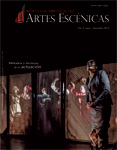Authors
Abstract
Accepting Donna Haraway’s invitation to think of ourselves as cyborgs like hybrids between machines and organimsm, the objective of this article is to
inquire about the possibilities of building truth as cyborgs in contemporary scenes. To achieve this purpose, the proposal is to problematize the acting
techniques, transgender and representation notions, and to open questions about how to build scenes with these cyborg bodies. Knowing that there is only reappropriation of a prosthesis world without revealing nature, training and acting composition should be designed in other ways. It may be worth playing surfaces without seeking the scenic truth, looking for partiality, irony, intimacy and perversity. Maybe it is necessary to engraft other prostheses and
simulate the pleasures that want to be generated.
In the line of intersection between theater, Anthropology and other social sciences, body techniques to produce “truth” on stage in a “post-organic” world will be investigated and tools to get into acting techniques from the perspective of cyborgs, prosthetic bodies made in interference between humans, animals, natures, organ machines, plastics, chimeras and realities will be looked for. How to build effective scenes with these bodies?
Keywords
References
Butler, J. (2004). Lenguaje, poder e identidad.Introducción. Madrid: Síntesis.
Cornago, Ó. (2006). Teatro postdramático: Las resistencias de la representación. En ARTEA / Sánchez, J.A. (Dir.), Artes de la escena y de la acción en España 1978-2002 (pp.165-179). Cuenca: UCLM. Disponible en
http://201.147.150.252:8080/xmlui/bitstream/handle/123456789/1316/teatropostdramatico_ocornago.pdf?sequence=1
Foucault, M. (1995). Theatrum philosophicum.Barcelona: Anagrama.
________. (2005). Vigilar y castigar. Nacimiento de la Prisión. Buenos Aires: Siglo XXI.
Haraway, D. (1995). Ciencia, cyborgs y mujeres.La reinvención de la naturaleza. Madrid:Cátedra.
Hogarutil.com. (2014). Receta de Salsa de tomate. Recuperado de http://www.hogarutil.com/cocina/recetas/salsas/201009/salsatomate-3119.html
Lehmann, H.-T. (2010). El teatro posdramático:una introducción. Telón de Fondo, 12.
Mauro, K.M. (2010). La concepción del cuerpo en la Actuación entendida como “interpretación”. Revista latinoamericana de estudios sobre cuerpos, emociones y sociedad, 4.
Mauss, M. (1979). Sociología y Antropología.2da, 6ta y 7ta parte. Madrid: Editorial Tecnos.
Preciado, B. (2011). Manifi esto contrasexual.Barcelona: Anagrama.
Sabores.com. (2012). Técnica para pelar tomate. Recuperado de htt p://sabores.com/tecnica-para-pelar-tomate/ Consultado el 06-08-14.
Serrano, R. (2004). Nuevas tesis sobre Stanislavski.Fundamento para una teoría pedagógica. Parte 1.Bs As: Atuel.
Sibilia, P. (2009). El hombre postorgánico.Cuerpo, subjetividad y tecnologías digitales.Buenos Aires: Fondo de Cultura Económica.
Schechner, R. (2000). Performance. Teoría & Prácticas Interculturales. Buenos Aires: Libros del Rojas. Universidad de Buenos Aires.
Žižek, S. (2008). En defensa de la Intolerancia.Madrid: Ediciones Sequitur.
________. (2013, 1 de junio). El hombre Nuevo.Página 12.

 PDF (Español)
PDF (Español)
 FLIP
FLIP









